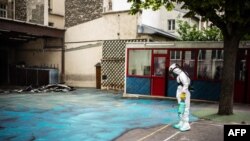Paris has closed all streets surrounding the Notre Dame Cathedral as workers prepare to decontaminate the area for high levels of lead.
The lead was found in the area surrounding the iconic church after it caught fire on April 15, destroying the structure's spires and parts of the roof.
"After the melting of at least 300 tons of lead in the gables of the spire and in the roof, Notre-Dame de Paris is now a polluted site," French environmental group Robin des Bois said in a statement. "The cathedral has now become filled with toxic waste."
High fences blocked vehicles and pedestrians from the area. A nearby railway station was also closed.
Cleanup crews will use two decontamination techniques. One involves spreading a gel on public benches, street lights and other fixtures to absorb the lead, letting it dry for several days before removing it. The other will feature high pressure water jets with chemical agents.
Reconstruction inside the gothic masterpiece was suspended last month for safety reasons. It is expected to restart next week. But the decontamination of the surrounding area is expected to last a lot longer.
For months, authorities in Paris had denied that lead poisoning was a threat. In late July, they finally admitted more needed to be done after high levels of lead were found at buildings as far as 1 kilometer away from the cathedral.
City authorities have vowed that all the nearby schools will be decontaminated by the time children return in early September.
President Emmanuel Macron has set a five-year goal to complete renovations on the 850-year-old structure, which is one of France's most popular tourists destinations. Before the fire, it received more than 10 million visitors annually.








